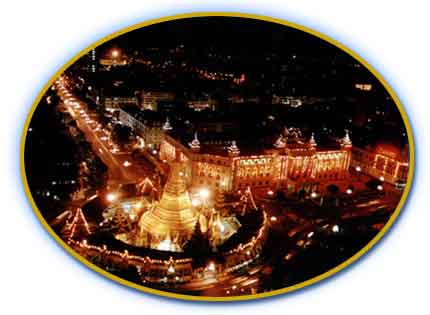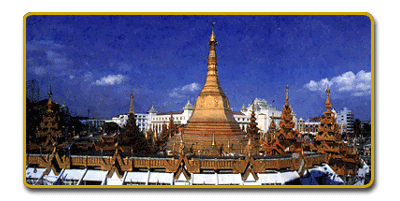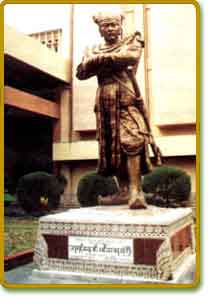When King Alaungpaya
conquered the small town of Dagon in 1755, he renamed it Yangon, meaning
'the end of strife.' The city was annexed by the British in 1851,
and changed its name to Rangoon. A pleasant mix of
colonial buildings and tree-shaded streets, with its Buddhist temples,
open-air markets, shady parks and beautiful lakes, Yangon has been
called the "Garden City of the East." It now covers an area of
about 500 square kilometres with a population close to five million.
![]() Shwedagon
Pagoda - Reputedly over 2500
years old, legend has it that the original stupa was constructed to
enshrine eight hairs of the Buddha. Over the years it has been rebuilt
many times until it now towers 98 metres over the city. One of the most
spectacular Buddhist shrines in Asia, it is plated with over 30 tons of
gold. Kipling aptly described the pagoda as "a beautiful winking
wonder." The base is surrounded by a fascinating assortment of
temples, shrines, statues and pavilions.
Shwedagon
Pagoda - Reputedly over 2500
years old, legend has it that the original stupa was constructed to
enshrine eight hairs of the Buddha. Over the years it has been rebuilt
many times until it now towers 98 metres over the city. One of the most
spectacular Buddhist shrines in Asia, it is plated with over 30 tons of
gold. Kipling aptly described the pagoda as "a beautiful winking
wonder." The base is surrounded by a fascinating assortment of
temples, shrines, statues and pavilions.


![]() People's
Square and People's Park - Set in
over 130 acres of land between Shwedagon Pagoda and the parliament
building of Pyithu Hluttaw (Parliament). The park also contains a
museum with life-size models of different national races in
national dress.
People's
Square and People's Park - Set in
over 130 acres of land between Shwedagon Pagoda and the parliament
building of Pyithu Hluttaw (Parliament). The park also contains a
museum with life-size models of different national races in
national dress.



![]() Sule
Pagoda - An octagonal pagoda 46
metres high in the centre of Yangon, said to date back over 2000 years
and enshrine a hair of Buddha. Surrounded by an assortment of small
shops, astrologists and palmists.
Sule
Pagoda - An octagonal pagoda 46
metres high in the centre of Yangon, said to date back over 2000 years
and enshrine a hair of Buddha. Surrounded by an assortment of small
shops, astrologists and palmists.
![]() Mahavijaya
Pagoda - The symbolic memorial of
the First Successful Congregation of the Sangha of All Orders held in
1980, this elegant Mahavijaya Pagoda is a unique blend of traditional
patterns and the modern styles. The sanctuary contains the Buddha image
and the reliquary donated by the King and Queen of Nepal.
Mahavijaya
Pagoda - The symbolic memorial of
the First Successful Congregation of the Sangha of All Orders held in
1980, this elegant Mahavijaya Pagoda is a unique blend of traditional
patterns and the modern styles. The sanctuary contains the Buddha image
and the reliquary donated by the King and Queen of Nepal.
![]() Bogyoke Aung San Park - With a lovely view of Kandawgyi Lake,
city-dwellers enjoy their leisure time in the playgrounds and picnic
areas.
Bogyoke Aung San Park - With a lovely view of Kandawgyi Lake,
city-dwellers enjoy their leisure time in the playgrounds and picnic
areas.

![]() Botahtaung
Pagoda - Its golden pagoda spire
rising to 40 metres, this pagoda is named after the thousand military
leaders ('bo', leader and 'tahtaung', thousand) who escorted relics
of the Buddha brought from India over two thousand years ago. The hollow
inside the spire has been turned into a museum.
Botahtaung
Pagoda - Its golden pagoda spire
rising to 40 metres, this pagoda is named after the thousand military
leaders ('bo', leader and 'tahtaung', thousand) who escorted relics
of the Buddha brought from India over two thousand years ago. The hollow
inside the spire has been turned into a museum.
![]() Chauk
Htat Gyi Pagoda - A short
distance beyond the Shwedagon Pagoda, this pagoda houses one of the
largest reclining Buddhas in Myanmar. The pagoda dates back to 1907 but
was restored in 1966.
Chauk
Htat Gyi Pagoda - A short
distance beyond the Shwedagon Pagoda, this pagoda houses one of the
largest reclining Buddhas in Myanmar. The pagoda dates back to 1907 but
was restored in 1966.
|
|
![]() Mai-Lamu
Pagoda - Contains giant images
depicting the previous lives of Buddha. About 20 minutes from the city
in North Okkalapa.
Mai-Lamu
Pagoda - Contains giant images
depicting the previous lives of Buddha. About 20 minutes from the city
in North Okkalapa.
![]() Kaba
Aye Pagoda - 34 metre high and 34
metres around its base, the pagoda was built in 1952 for the Sixth
Buddhist Synod in 1954 - 1956. Its name means "World Peace."
Located 11 km north of the city beyond the Inya Lake Hotel.
Kaba
Aye Pagoda - 34 metre high and 34
metres around its base, the pagoda was built in 1952 for the Sixth
Buddhist Synod in 1954 - 1956. Its name means "World Peace."
Located 11 km north of the city beyond the Inya Lake Hotel.
![]() Martyrs'
Mausoleum - On a hill overlooking
the city, close to the Shwedagon, this memorial is dedicated to Bogyoke
Aung San - who played a key role in securing independence from the
British. He was assassinated along with fellow cabinet members in 1947.
Martyrs'
Mausoleum - On a hill overlooking
the city, close to the Shwedagon, this memorial is dedicated to Bogyoke
Aung San - who played a key role in securing independence from the
British. He was assassinated along with fellow cabinet members in 1947.
![]() National
Museum - Exhibits include the
Lion Throne of King Thibaw, the country's last monarch, 19th century
Royal Regalia, a collection of gem studded arms, swords, jewellery,
paintings, and musical instruments.
National
Museum - Exhibits include the
Lion Throne of King Thibaw, the country's last monarch, 19th century
Royal Regalia, a collection of gem studded arms, swords, jewellery,
paintings, and musical instruments.
![]() Zoological
Garden - Opened in 1906 it houses
a variety of wild animals. On weekends or public holidays there are
snake shows and elephant performances.
Zoological
Garden - Opened in 1906 it houses
a variety of wild animals. On weekends or public holidays there are
snake shows and elephant performances.
![]() Hlawga
Wildlife Park - Home to over 70
kinds of herbivorous animals and 90 species of birds, the park covers
1,650 acres. Flocks of migratory birds also frequently visit the park.
About 45 minutes from the city, the Park also offers elephant rides,
boating and fishing.
Hlawga
Wildlife Park - Home to over 70
kinds of herbivorous animals and 90 species of birds, the park covers
1,650 acres. Flocks of migratory birds also frequently visit the park.
About 45 minutes from the city, the Park also offers elephant rides,
boating and fishing.
![]() Allied
War Memorial Cemetery - 27,000
graves of Commonwealth and Allied soldiers who died in the Myanmar
Campaign during WW2 are spread throughout the beautifully maintained
grounds at Htaukkyant, about 32 km from Yangon.
Allied
War Memorial Cemetery - 27,000
graves of Commonwealth and Allied soldiers who died in the Myanmar
Campaign during WW2 are spread throughout the beautifully maintained
grounds at Htaukkyant, about 32 km from Yangon.

